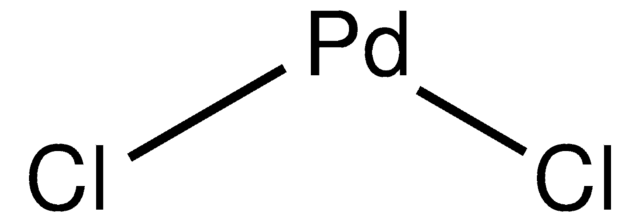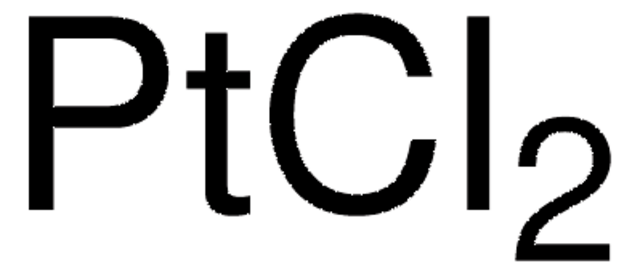205796
Potassium tetrachloropalladate(II)
98%
Sinônimo(s):
Potassium palladium(II) chloride
About This Item
Produtos recomendados
Nível de qualidade
Ensaio
98%
forma
crystals
pf
105 °C (dec.) (lit.)
densidade
2.67 g/mL at 25 °C (lit.)
cadeia de caracteres SMILES
[K+].[K+].Cl[Pd--](Cl)(Cl)Cl
InChI
1S/4ClH.2K.Pd/h4*1H;;;/q;;;;2*+1;+2/p-4
chave InChI
LGCKLDWLSVFMGL-UHFFFAOYSA-J
Procurando produtos similares? Visita Guia de comparação de produtos
Categorias relacionadas
Descrição geral
Aplicação
- As a precursor to synthesize Pd nanoparticles for catalytic degradation of organic pollutants and Pd-GO electrocatalyst in formic acid and ethanol oxidation.
- To synthesize Pd–Pt alloy nanocrystals (NCs) with hollow structures by a galvanic replacement method with uniform Pd octahedral and cubic NCs as sacrificial templates. The hollow NCs exhibited higher ORR activities.
- To synthesize immobilized Pd catalysts, a versatile method involves the layer-by-layer deposition of PAA and PEI-Pd(II) on alumina, followed by the reduction of Pd2+. This approach offers several benefits, including the stabilization of particles through the polyelectrolyte matrix, introduction of selectivity, and a significant reduction in undesired isomerization. Expanding the application of polyelectrolyte films holds promise for further enhancing selectivity in hydrogenation and other reactions.
- To fabricate conductive and porous metal-organic frameworks(MOFs) for gas sensing applications and also to synthesize bimetallic Pd/SnO2 nanoparticles on metal organic framework (MOF) as an electrocatalyst for ethanol oxidation.
- To prepare rigid macrocyclic pincer catalysts possessing polyaromatic ligands with enhanced catalytic activity.
Características e benefícios
Palavra indicadora
Warning
Frases de perigo
Declarações de precaução
Classificações de perigo
Eye Irrit. 2 - Skin Irrit. 2 - STOT SE 3
Órgãos-alvo
Respiratory system
Código de classe de armazenamento
11 - Combustible Solids
Classe de risco de água (WGK)
WGK 3
Ponto de fulgor (°F)
Not applicable
Ponto de fulgor (°C)
Not applicable
Equipamento de proteção individual
dust mask type N95 (US), Eyeshields, Gloves
Escolha uma das versões mais recentes:
Já possui este produto?
Encontre a documentação dos produtos que você adquiriu recentemente na biblioteca de documentos.
Os clientes também visualizaram
Nossa equipe de cientistas tem experiência em todas as áreas de pesquisa, incluindo Life Sciences, ciência de materiais, síntese química, cromatografia, química analítica e muitas outras.
Entre em contato com a assistência técnica









